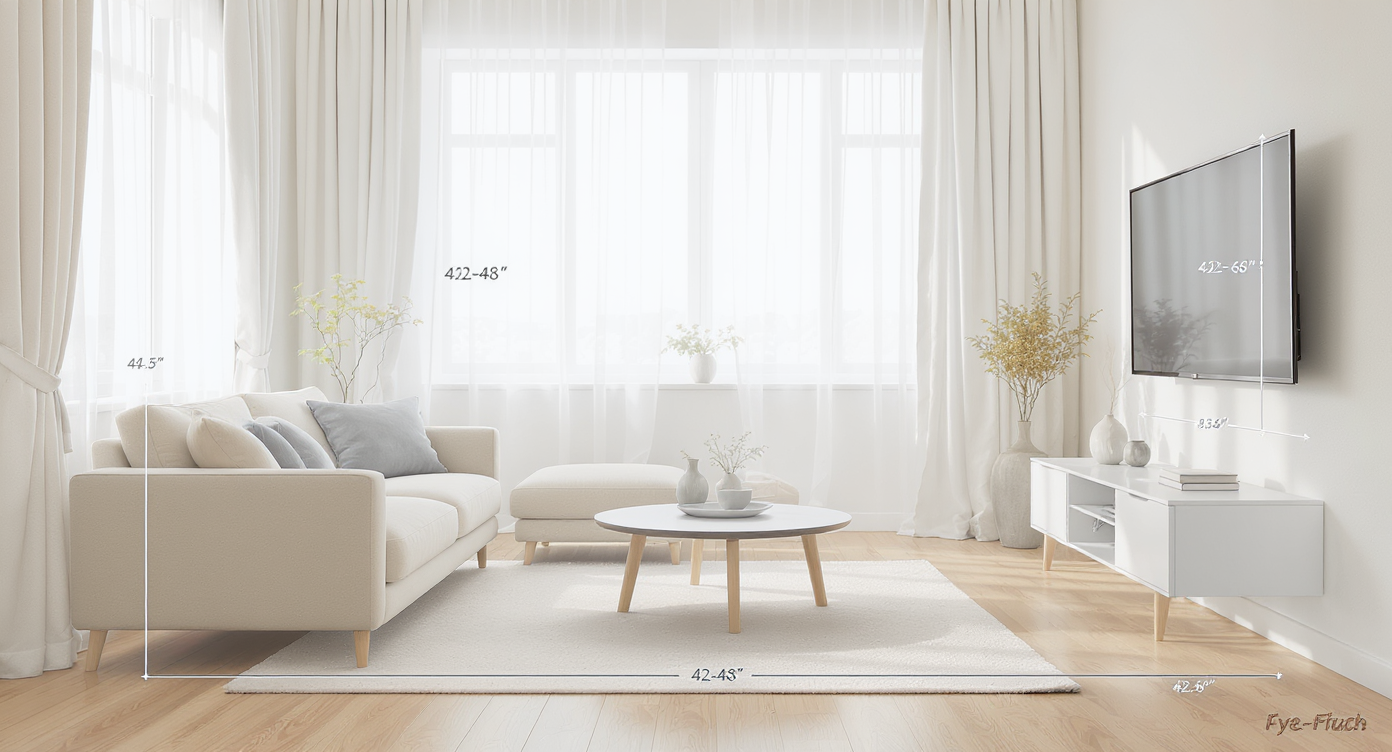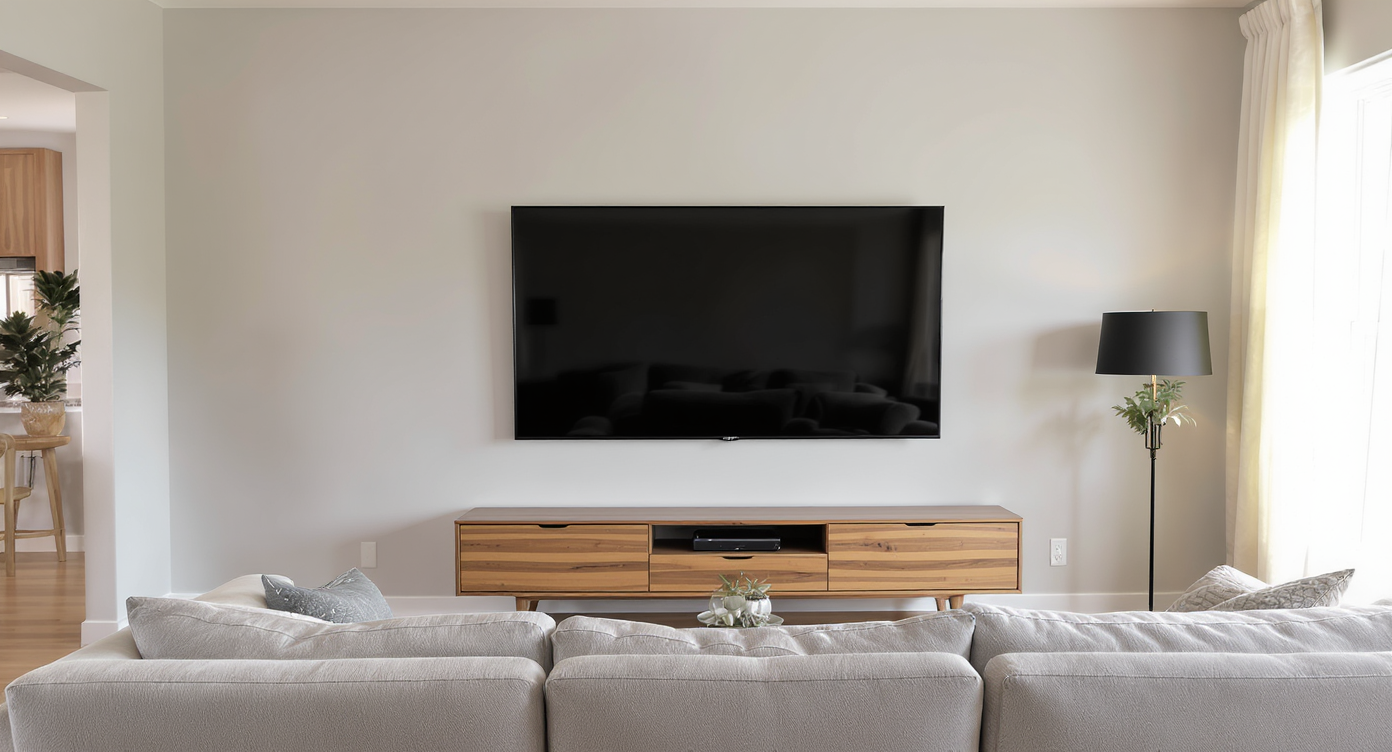TL;DR
For most living rooms, the ideal TV height places the screen’s center 42–48 inches from the floor, aligning with seated eye level. If you’re asking how high to mount a TV on the wall, use your actual sofa seat height and eye level to dial it in; adjust lower for kids and add a slight tilt in bedrooms.
Why TV Height Matters More Than You Think

Aligning your TV center with seated eye level reduces neck strain and glare for better viewing.
Your TV should meet your eyes, not your chiropractor. The best TV height places the screen’s center roughly at seated eye level, usually 42–48 inches from the floor for living rooms.
Here’s the thing: TV height is less about a universal number and more about your seating, viewing distance, and screen size. Search terms like TV wall mount, TV placement, and best TV height for living room often assume a one-size-fits-all solution. But real homes vary. Seat heights range from 16 to 22 inches, coffee tables reflect glare, and some living rooms are also playrooms or home offices. Designers often advise starting with your eye level and working outward from there.
If you’ve ever craned your neck during a movie night or battled afternoon glare, you already know why this matters. A few inches up or down can change everything, whether you’re mounting above a fireplace, in a bedroom, or over a media console. Image alt text idea: "diagram of TV height at 42–48 inches to center." Caption: "TV center aligned to seated eye line improves comfort and clarity."
The Simple Formula: Ideal TV Mounting Height
Experts recommend setting the TV’s center at seated eye level: typically 42–48 inches from the floor in a standard living room. This eye-level rule of thumb reduces neck strain and keeps the picture within your natural line of sight.
Short answer for TV placement: measure your seated eye height from the floor, then mount so the TV’s center aligns with that measurement. On many sofas, seated eye height averages 40–44 inches; if that’s you, a 42–48 inch center works well. If your sofa is taller or you sit upright at a dining banquette, shift higher. For a TV over a console, keep the bottom edge 6–12 inches above the top surface to avoid a cramped look.
- Bedroom TV height: Lower than living rooms if you watch while reclining, or maintain the 42–48 inch center and add a 5–15 degree tilt. Tilting compensates for higher placements without straining your neck.
- Over a fireplace: Keep the TV center no higher than 60 inches if possible. If the mantle forces it higher, use a tilt or a pull-down mount to bring the screen closer to eye level.
- Viewing distance: A practical range is 1.2–1.6 times the screen diagonal. For a 65-inch TV, that’s about 6.5–8.5 feet.
One homeowner told me their "aha" moment was simply taping a paper dot at 44 inches on the wall and aligning the TV center to it. The room instantly felt calmer, and late-night binges stopped causing a stiff neck.
Anecdote
A family of five swapped a wall-mounted 50-inch TV from 58 inches to 45 inches to center after constant complaints. Game nights felt calmer, and kids stopped sitting on the floor; the screen finally lined up with the sofa’s real-life eye level.
Common TV Mounting Mistakes (and Easy Fixes)
Most mounting mistakes come from setting the TV too high, underestimating glare, or ignoring seat height. A quick mockup can prevent all three.
- Mounting too high: It happens because walls feel taller than they are. If you’re above 60 inches to center in a living room, expect neck tilt. Fix with a lower mount or a 5–10 degree tilt.
- Ignoring seat height: A 6-foot-tall viewer and a 5-foot-tall viewer don’t share the same eye line. Measure seated eye levels for the primary viewers and average them.
- Wrong distance for screen size: Sitting 12 feet from a 50-inch TV makes text and detail hard to see. Use the 1.2–1.6x diagonal guideline to choose size or rearrange seating.
- Glare blindness: Afternoon sun from a side window can wash out colors. Rotate the TV with a full-motion arm or add light-dimming treatments.
- Forgetting cable management: Messy cords ruin the clean look. Use in-wall rated cable kits or paintable raceways to keep wires invisible.
Pro Tips Designers Swear By
Designers often advise starting with painter’s tape at your target center height, then living with it for 24 hours. If it feels natural day and night, you’re ready to drill.
- Use a cardboard cutout: Trace your TV’s outline and tape it at the proposed height. Sit, lounge, and stand. Adjust until it disappears into your sightline.
- Console coordination: If you have a media console, aim for the TV bottom 6–12 inches above it and 2–6 inches narrower on each side for balanced proportions.
- Studs matter: Always mount into studs or use a rated wall anchor system. Check the mount’s VESA pattern and weight rating.
- Bedroom tilt trick: For higher placements, add a 10–15 degree tilt to aim the screen at your pillow, reducing glare and neck strain.
- Test glare with a mirror: Hold a hand mirror where the screen will be. If you see a window in the mirror, you’ll see it in your TV; shift or tilt accordingly.
I’ve seen this: the minute someone lowers a too-high TV by even 4 inches, the room feels calmer, like the furniture and screen finally agree on the focal point.
Real Rooms, Real Fixes: Quick Stories
Small adjustments in TV placement often unlock comfort, scale, and a cleaner look. Think inches, not feet.
- The 62-inch mistake: One couple mounted their TV at 62 inches to center because the wall felt "right." Movie nights ended with sore necks. Lowering the center to 44 inches and adding a soft tilt ended the strain immediately.
- Renter’s workaround: A renter leaned a 55-inch TV on a low console, worried it would look temporary. Tucking a 2-inch rubber bumper behind the upper edge created a subtle backward tilt, improved contrast, and looked intentional.
- Bedroom reality check: A 50-inch TV above a tall dresser felt towering. They moved it to a wall opposite the bed at 45 inches to center and set a 12-degree tilt. Suddenly, evening shows didn’t feel like a flight safety demo.
- Fireplace fix: A living room with a deep mantle forced a high mount. A pull-down mount brought the screen down 10 inches for viewing and retracted when not in use. Bonus: less heat exposure, clearer picture.
Visualization Scenario
Picture a 12-by-18-foot living room. The sofa sits 8 feet from a 65-inch TV. You tape a dot at 44 inches on the wall, then center the TV on that mark. The console sits 9 inches below the screen’s bottom edge. Afternoon light hits from the left, so you choose a mount with 10 degrees of tilt. When you sit, the image meets your eyes without effort. The room feels quiet, even before you press play.
TV Height FAQ
- How high should I mount a 65-inch TV? For a 65-inch TV, aim for 42–48 inches from floor to screen center in a living room. Adjust based on seated eye height and add a slight tilt if mounted higher.
- What’s the best TV height above a fireplace? Keep the TV center near eye level and under 60 inches when possible. If the mantle forces a higher mount, use a tilt or pull-down mount to reduce neck strain.
- How far should I sit from my TV? A practical viewing distance is 1.2–1.6 times the TV’s diagonal. For 55 inches, that’s about 5.5–7 feet; for 75 inches, roughly 7.5–10 feet.
- How high should I mount a TV in a bedroom? Mount slightly lower or add a 10–15 degree tilt to aim at your reclined eye line. Many bedrooms still work with a 42–48 inch center, adjusted for pillow height.
- Should a TV be higher over a media console? Leave 6–12 inches between the console top and the TV bottom for balanced proportions. Maintain eye-level center if seating and sight lines allow.
Make Comfort the Rule, Not the Exception
Perfect TV height isn’t a mystery. Start with eye level, usually 42–48 inches to the screen’s center, then refine with tilt, distance, and glare checks. If it feels natural from your favorite seat, you got it right. And if you’re debating size or placement, mock it up and trust what your body tells you after a night of viewing.
Want to preview the setup before drilling holes? Use a visualization tool like ReimagineHome to test TV placement, console proportions, and wall compositions in minutes.
.svg)

.svg)














.png)